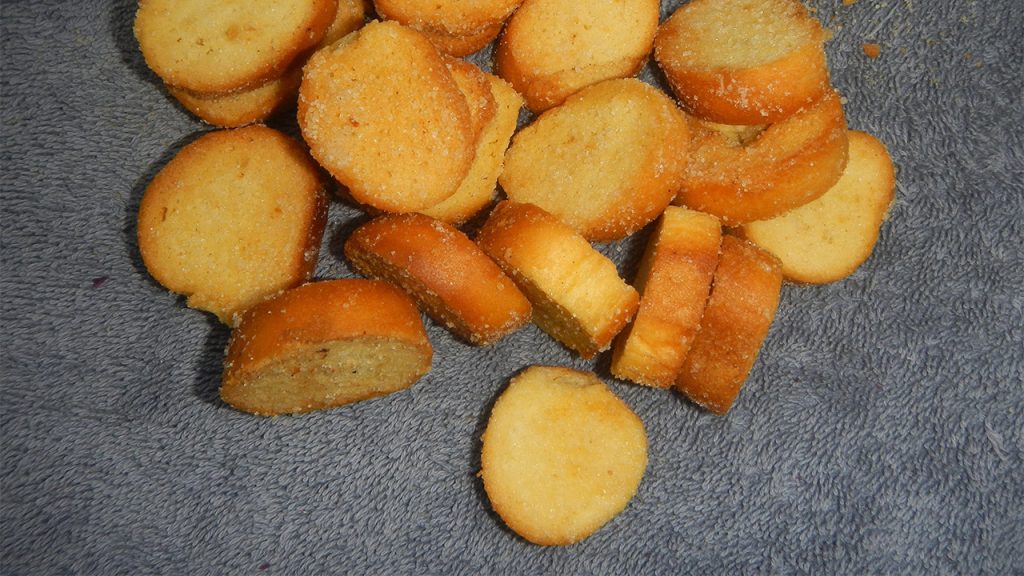
Biskwit is the Filipino term encompassing traditional biscuits, cookies, and crackers that have been part of the local culinary culture for centuries. Many of these were introduced by the Spaniards, later adapted to cater to Filipino tastes, ingredients, and preferences. Their flavor profile leans toward sweet instead of salty, and their textures are crunchier than chewy and tender.
Cooking is usually done by baking or sometimes by frying. The main components are flour, eggs, and milk, but localized versions make use of regional ingredients such as arrowroot flour, cassava flour, glutinous rice flour, coconut milk, anise, and dayap.
Biskwit is consumed as a morning or afternoon snack, given as a treat to children, served with coffee or hot chocolate, and paired with other local dishes like pancit.
Here is a selection of the most popular types of biskwit found all over the Philippines:
Alfajor
Alfajores in other countries are coated in desiccated coconut or dipped in chocolate, but the Filipino version is a simple cookie sandwich with a caramel filling.
Its shortbread base is heavily flavored with butter and lemon rind. It is dusted with confectioner’s sugar before packing.
Barquillos
Named after its Spanish counterpart, barquillos is a light and thin wafer roll with a creamy and buttery flavor profile.
It is made by cooking a batter of flour, sugar, butter, and eggs on a hot plate then wrapping each wafer around a steel rod.
Biscocho
The Spanish term “bizcocho” refers to different pastries and cakes, but in the Philippines, it refers to twice-baked breads.
The crunchy biscuit is typically coated in butter and sugar upon baking. Other recipes add garlic for a savory version.
Broas
With a crunchy exterior and a sponge-like interior, broas is the Filipino version of ladyfingers.
It is traditionally made with only flour, eggs, and sugar, then baked in a charcoal oven.
Camachile
Made with flour, baking powder, baking soda, eggs, and margarine, the camachile takes its name and shape from the fruit of the same name.
In the city of Malabon, the biscuit is served alongside every plate of pancit Malabon.
Galletas
Galletas are brown, square biscuits with shiny surfaces and upturned corners.
They are also called galletas de patatas, galletas de huevos, tenga ng daga, or egg cracklets because of their prominent egg flavor.
Lengua de gato
In Spanish, “lengua de gato” means “cat’s tongue,” which refers to the thin, elongated shape of this biscuit.
Despite being baked until crisp, lengua de gato is milky and buttery. It easily melts in the mouth.
Otap
Originating from Cebu, otap is also sometimes called hojaldres or “puff pastry,” which refers to its very flaky texture.
The oval-shaped biscuit is made of layers of pastry sheets sweetened with sugar and baked until crisp on top.
Paborita
A favorite biscuit of many, especially in the Southern Tagalog region, the paborita is made of wheat flour, baking powder, alum, and skim milk.
These small, brown discs have a flaky texture and taste much like galletas.
Pacencia
Pacencia is a button-shaped, airy, drop cookie made out of egg whites and sometimes flavored with vanilla, calamansi, or lemon.
This is named after the virtue of patience, as one typically needs a great deal of it to whip up the egg whites.
Pilipit
In Filipino, “pilipit” means twisted, which describes the shape of this biscuit.
The small and crunchy pilipit is made with flour, baking powder, eggs, and milk. It is baked then coated with a sugar glaze or caramel.
Puto seko
In Spanish, “seco” means dry, which alludes to the texture of these cookies.
Made with cornstarch, glutinous rice, eggs, and butter, puto seko is baked until crumbly, brittle, and almost powdery.
Rosquillos
This biscuit is shaped like a ringlet, or rosca in Spanish, with scalloped edges.
Made with flour, baking soda, sugar, shortening, and eggs, rosquillos biscuits hail from Lilian, Cebu and were created in 1907.
Sanikulas
Introduced by Augustinian friars, these cookies are made in honor of San Nicolas de Tolentino, whose image is pressed on the sanikulas using a traditional wooden mould.
The thin, oval-shaped cookies are made with arrowroot flour, coconut milk, and dayap or anise for flavor.
Uraro
This biscuit takes its name from its main ingredient, the arrowroot, which goes through a rigorous process to come up with the starch.
A popular product of the Southern Luzon region, the flower-shaped uraro has a dry texture, but it easily melts in the mouth.


Recent Comments